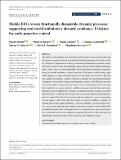Files in this item
Mobile EEG reveals functionally dissociable dynamic processes supporting real-world ambulatory obstacle avoidance : evidence for early proactive control
Item metadata
| dc.contributor.author | Mustile, Magda | |
| dc.contributor.author | Kourtis, Dimitrios | |
| dc.contributor.author | Ladouce, Simon | |
| dc.contributor.author | Learmonth, Gemma | |
| dc.contributor.author | Donaldson, David I. | |
| dc.contributor.author | Edwards, Martin G. | |
| dc.contributor.author | Ietswaart, Magdalena | |
| dc.date.accessioned | 2021-09-20T09:30:02Z | |
| dc.date.available | 2021-09-20T09:30:02Z | |
| dc.date.issued | 2021-02-07 | |
| dc.identifier | 272465879 | |
| dc.identifier | 14b15181-60c8-4a39-add2-7c4fe0d8a911 | |
| dc.identifier | 85100599615 | |
| dc.identifier | 000615784500001 | |
| dc.identifier.citation | Mustile , M , Kourtis , D , Ladouce , S , Learmonth , G , Donaldson , D I , Edwards , M G & Ietswaart , M 2021 , ' Mobile EEG reveals functionally dissociable dynamic processes supporting real-world ambulatory obstacle avoidance : evidence for early proactive control ' , European Journal of Neuroscience , vol. Early View . https://doi.org/10.1111/ejn.15120 | en |
| dc.identifier.issn | 0953-816X | |
| dc.identifier.other | RIS: urn:9BC8B7BA6E323FC57F2638ABF2AF7836 | |
| dc.identifier.other | ORCID: /0000-0002-8036-3455/work/100549786 | |
| dc.identifier.uri | https://hdl.handle.net/10023/23988 | |
| dc.description | This work is supported by a scholarship from the University of Stirling and a reseach grant from SINAPSE (Scottish Imaging Network: A Platform for Scientific excellence). GL is supported by the Wellcome Trust [209209/Z/17/Z]. | en |
| dc.description.abstract | The ability to safely negotiate the world on foot takes humans years to develop, reflecting the huge cognitive demands associated with real‐time planning and control of walking. Despite the importance of walking, methodological limitations mean that surprisingly little is known about the neural and cognitive processes that support ambulatory motor control. Here, we report mobile EEG data recorded from thirty‐two healthy young adults during real‐world ambulatory obstacle avoidance. Participants walked along a path while stepping over expected and unexpected obstacles projected on the floor, allowing us to capture the dynamic oscillatory response to changes in environmental demands. Compared to obstacle‐free walking, time‐frequency analysis of the EEG data revealed clear frontal theta and centro‐parietal beta power neural markers of proactive and reactive forms of movement control (occurring before and after crossing an obstacle). Critically, the temporal profile of changes in frontal theta allowed us to arbitrate between early selection and late adaptation mechanisms of proactive control. Our data show that motor plans are updated as soon as an upcoming obstacle appears, rather than when the obstacle is reached. In addition, regardless of whether motor plans required updating, a clear beta rebound was present after obstacles were crossed, reflecting the resetting of the motor system. Overall, mobile EEG recorded during real‐world walking provides novel insight into the cognitive and neural basis of dynamic motor control in humans, suggesting new routes to the monitoring and rehabilitation of motor disorders such as dyspraxia and Parkinson’s disease. | |
| dc.format.extent | 14 | |
| dc.format.extent | 1297161 | |
| dc.language.iso | eng | |
| dc.relation.ispartof | European Journal of Neuroscience | en |
| dc.subject | Action planning | en |
| dc.subject | Embodied cognition | en |
| dc.subject | Gait adaptation | en |
| dc.subject | Motor control | en |
| dc.subject | Walking | en |
| dc.subject | BF Psychology | en |
| dc.subject | RC0321 Neuroscience. Biological psychiatry. Neuropsychiatry | en |
| dc.subject | DAS | en |
| dc.subject.lcc | BF | en |
| dc.subject.lcc | RC0321 | en |
| dc.title | Mobile EEG reveals functionally dissociable dynamic processes supporting real-world ambulatory obstacle avoidance : evidence for early proactive control | en |
| dc.type | Journal article | en |
| dc.contributor.institution | University of St Andrews. School of Psychology and Neuroscience | en |
| dc.identifier.doi | 10.1111/ejn.15120 | |
| dc.description.status | Peer reviewed | en |
This item appears in the following Collection(s)
Items in the St Andrews Research Repository are protected by copyright, with all rights reserved, unless otherwise indicated.

